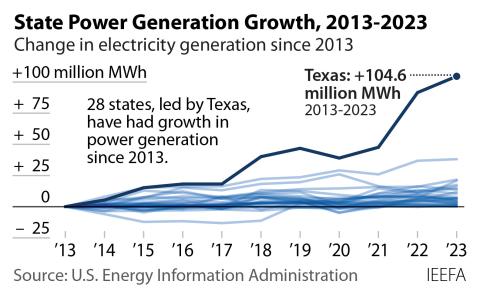Wyoming Regulators Say Peabody Complies with Self-Bonding Requirements, but They Don’t Say How
Wyoming’s Department of Environmental Quality recently affirmed Peabody Energy’s alleged ability to self-bond, that is, pay for the vast cleanup costs associated with its mines in the Powder River Basin rather than stick taxpayers with the bill. To the naked eye, however, Peabody—or for that matter Arch Coal or Alpha Natural Resources—is in no position to deliver on the self-bonding promises they have made.
These three companies have gained industry prominence in part for their self-bonding allowances. The government gives them a waiver on paying market rates for cleanup insurance so long as they show they have the assets to deliver on their self-bonding promises. Each mine applies for self-bonding status and so, on paper, at least, each mine stands before regulators as a financial proposition on its own. “The Name Is Bond. Self-Bond” was the catchy headline the other day over at IHS Coal and Energy Review.
The Wyoming Department of Environmental Quality isn’t revealing much about its Peabody decision, so it’s hard to fathom what went into it. Alpha has already failed the compliance test (and is challenging it). Arch faces similar scrutiny. Some critics are appealing Wyoming’s unwillingness to open its books, which the state should do. Sunlight can unmask the truth, as it did two years ago when the Texas Railroad Commission released the sordid details of the self-bonding program for mines owned by Energy Future Holdings, the now-bankrupt utility giant.
ABSENT MORE DISCLOSURE IN WYOMING WE KNOW ONLY WHAT WE SEE, THAT PEABODY ENERGY IS IN FINANCIAL TROUBLE. Part of its problem is that it is so deeply in debt and that its coal mines—its assets—are not producing enough revenue to cover expenses and debt service and still make a profit. The company is declaring losses across its entire enterprise.
At the enterprise-wide level, then, which is what investors look at when determining if a company is viable, Peabody cannot meet its reclamation obligations. Its Powder River Basin mines, in fact, are not free and clear assets, but part of Peabody’s enterprise writ large. The company’s Western Region operation in the U.S. is faring a little better than, say, its debt-burdened operations in Australia, some or perhaps all of which Peabody is selling. So revenue from its Western Region mining-operation profits, such as they are, support Peabody’s struggling global enterprise..
In the strange world of self-bond regulation an audit of Peabody’s Rochelle mine, for example, might show that it produces a positive cash flow and that very little in the way of long-term debt is attributed to it. Thus, a narrow reading of the regulations might suggest that the Rochelle mine complies with self-bonding requirements. By presenting only the financial condition of the subsidiary, Peabody is spinning a picture of compliance, although that picture has been cropped. In reality, the mine, which appears to be profitable, is pledged to Peabody’s overall failing enterprise.
We may never know how the Wyoming Department of Environmental Quality reached its decision, but this much we remember: Energy Future Holdings, that now famously bankrupt Texas utility, was able to maintain a similar posture with Texas regulators as its assets deteriorated. The Texas commission required additional proof of self-bonding cash resources only when the company declared bankruptcy. But even that sleepy group of regulators had only required more frequently updated financial reporting a few months earlier, as it came to realize that the company was circling the drain.
If the parent is weak, so are the subsidiaries—and this is as true of the coal industry as it is of any industry.
THERE’S MORE, AS PLATTS COAL TRADER NOTED LAST WEEK IN REPORTING AN OBSERVATION OF INTEREST by an anonymous but presumably well-informed source:
“Peabody was likely less exposed to the self-bonding requirements because it has more assets and market capitalization than either Arch or Alpha, said one industry source. ‘That’s probably what’s saving them,’ the source said. Peabody, Alpha and Arch Coal would have roughly $400 million in reclamation liability for every 40 million (short tons) in their self-bonded mines in Wyoming, the source said. That prospect has kept struggling mines, particularly PRB 8,400 Btu/lb mines, operating despite increasing losses, he said. ‘If you shut down any of those mines, you’re on the hook for that $400 million in reclamation,’ the source said. ‘It’s more economical for these mines to keep running at reduced rates so they don’t have this reclamation liability.’”
The Platts source illuminates our point, that the system allows assets to be considered separate and apart from the liabilities they carry. On paper, the Rochelle mine is an asset, true. Against Peabody’s enterprise as a whole, however, it is swallowed in the larger troubled-liability picture.
What the Platts source says also makes us wonder even more about the Wyoming decision. Peabody’s two other Powder River Basin mines, Caballo and Rawhide, accounted for about 15 percent of the company’s 140 million tons of Powder River Basin production in 2014. Both of those mines produce lower-quality coal than Rochelle. Peabody has reduced production out of Caballo by 50 percent over the last year or so, and we do not know if Rawhide is profitable. What are the asset values of these two mines and how do they comply with the self-bonding requirement? We see no asset writedowns in Peabody’s official SEC filings despite the obvious diminished usefulness of these assets to the company’s production portfolio.
Maybe there’s a good financial explanation for how Peabody’s technically legal compliance protects the public against cleanup liabilities. Or maybe it’s just another sordid example of rules being gamed and regulators playing the fool.
Tom Sanzillo is IEEFA’s director of finance.











